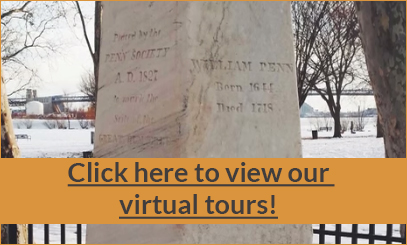The 1682 Treaty of Friendship has captured the imagination of many. The Treaty Tree became a living symbol of the event. It marked the location of the site until it fell in a great storm on March 5, 1810. Concern arose that the story and the site would be forgotten. An obelisk, secured by private funding, was placed on private property in 1827 to mark the location of the Tree.
On January 25, 1892, the Philadelphia City Council and the Fairmount Park Art Commission collaborated to establish Penn Treaty Park.
Etta May Pettyjohn, daughter of a Fishtown tugboat captain, graduated from Kensington High School, received bachelor’s, master’s and doctoral degrees from the University of Pennsylvania and returned to Kensington High School as principal from 1956 – 1971. Her vision for a Penn Treaty Museum became the catalyst for community action. A group of local citizens formed a Tercentenary Committee to expand the park. Six additional acres of land became part of the park in 1982. Dr. Pettyjohn’s ideas for a museum caught hold with members of the Committee and acquisition of items for a museum began in 1987.
In 2007, in honor of the 325th anniversary of the Treaty of Friendship, the acquisitions were on display for the first time and a virtual museum established. By 2009 a 501 (c)(3) non-profit was established and a Board of Directors in place.
Today, the museum has evolved from a website to a bricks and mortar facility with collection of Treaty related artifacts on display, a volunteer staff and projects to ensure that the story of the original stewards of the land and William Penn endures.
The museum hosted a celebration of the 200th anniversary of the Tree (2010) with a lecture and exhibit at the Historical Society of Pennsylvania, lecture at the Philadelphia Flower Show about elms, a meeting with Native Americans, Quakers and citizens at the Arch Street Meeting House followed by a ceremony with Nanticoke Lenni Lenape in Penn Treaty Park.
In March 2015, the museum sponsored a bus trip to Washington, D.C. to visit the National Museum of the American Indian exhibit Nation to Nation: Treaties between the United States and the American Indian Nation that showcases a box from the Penn Treaty Museum collection made from Treaty Tree wood that was given by Roberts Vaux to a Mr. Powell.
The museum supports the Pennsylvania Core Curriculum Standards for Social Studies for fourth grade students through field trips to the park and collection. Students come away with an understanding of the Treaty with the original stewards of the land and Penn. In 2017, the museum received a grant from the Indian Committee of the Philadelphia Yearly Meeting of the Religious Society of Friends to expand activities.
As part of the museum’s educational outreach program an essay contest for fourth grade students takes place annually. The contest, in memory of Jake Powell, a true Friend of the museum, gives students an opportunity to write about what friends mean to them. Please see “Friendship” for winning entries
“Penn Treaty,” a metal plate sculpture by Bob Haozous, is dedicated to Native Americans. The sculpture features elements from the wampum belt as well as symbols of nature and technology. It blended in with the urban area by day and was almost invisible at night. Through the efforts of the museum in 2015, the sculpture is now illuminated at night and serves as a glowing tribute to the brief time Native Americans and newly arrived settlers lived in harmony.
The museum pauses each September 21 to remember International Peace Day with the presentation of a “tree child” from the Haverford College Arboretum. The “tree child” is a descendant of the original elm that became the symbol of the Treaty of Friendship. Recipients include: Peace Garden/Sacred Heart, Camden, NJ; Ken Burns, Film maker; St. John’s United Methodist Church, Bridgeton, NJ during “5th Sunday Native American Sunday.”
In 2019, the museum restored and illuminated a neon sculpture by Duane Linklater, an Omaskeo Ininiwak, that had been abandoned and vandalized. Entitled “In Perpetuity,” the words of Chief Tamanend, executed in bright red neon, remind all of the Treaty of Friendship and the desire to have the treaty last. .
“As long as the creeks and rivers flow and the sun, moon and stars endure”
Recently, the museum received an unrestricted grant in support of the museum’s mission from the Welcome Society, a non-profit educational organization with a focus on William Penn, Quakers and the ship “Welcome.”
The museum continues to create audio tours that are available on a smart phone to highlight objects in the Penn Treaty Park that relate to the Treaty of Friendship.
